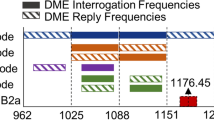Abstract
The evaluation of signal structure is an important phase of the signal structure design in the process of GPS modernization, Galileo and BDS construction. The new generation navigation signals of global navigation satellite system (GNSS) have the characteristics of diversification of signal structure, large bandwidth and complicated receiving method. Based on this, a new generation signal structure evaluation system (NGSSES) was proposed. The NGSSES is flexible to configure, and the bandwidth and sampling rate can up to 250 and 150 MHz, respectively. The output signals have the power of resolution of 0.5 dB. The performance of code and carrier tracking accuracy of BOC(14,2) under single channel and channel combining tracking methods, multipath of TMBOC(6,1,4/33) under matching and non-matching methods are evaluated using NGSSES. The anti-jamming performance of BOC(14,2) and AltBOC(15,10), compatibility of BDS B1 BOC(14,2) and GPS L1M BOC(10,5) are also evaluated using NGSSES. The experimental results verified the feasibility and effectiveness of NGSSES.
Access this chapter
Tax calculation will be finalised at checkout
Purchases are for personal use only
Similar content being viewed by others
References
Correia JT, Blanchard JJ, Fine PB (2000) A hardware testbed for evaluation of the GPS modernization modulation candidates. In: Proceedings of ION NTM, Anaheim, CA, pp 594–604
Dafesh PA, Bow RT, Partridge MD et al (2002) Simulation and hardware demonstration of new L2 civilian GPS ranging codes. In: Proceedings of the ION NTM, San Diego, CA, pp 925–930
Dafesh PA, Wong RL, Partridge MD et al (2001) Measurements of GPS receiver compatibility with interplex-modulated M-code signals. In: Proceedings of ION AM, Albuquerque, NM, pp 100–108
Hsu J, Choy A, Powell TD et al (2009) Initial on-orbit observations of the L5 demo payload on GPS IIR-20. In: Proceedings of ION GNSS, Savannah, GA, pp 76–85
De Gaudenzi R, Hoult N, Batchelor A et al (2001) Galileo signal validation development. In: Proceedings of seventh international workshop on digital signal processing techniques for space communications, Sesimbra, Portugal
Simsky A, Sleewaegen JM, De Wilde W et al (2005) Overview of Septentrio’s galileo receiver development strategy. In: Proceedings of ION GNSS, Long Beach, CA, pp 1888–1895
Soellner M, Briechle C, Hechenblaikner G et al (2007) The BayNavTech™ Signal Experimentation Facility (BaySEF™) is ready for assessing GNSS signal performance. In: Proceeding of the ION GNSS, Fort-Worth, Texas, pp 1065–1072
UNOOSA (2010) Current and planned global and regional navigation satellite systems and satellite-based augmentation systems [EB/OL]. http://www.unoosa.org/pdf/publications/icg_ebook.pdf. Accessed 29 June 2010
Yang Y (2010) Progress, contribution and challenges of compass/BeiDou satellite navigation system. Acta Geodaetica Cartogr Sin 39(1):1–6
Liu L, Zhan X, Liu W et al (2011) Assessment of radio frequency compatibility between compass and GPS. Acta Geodaetica Cartogr Sin 40(Sup.):11–18
Hu Z (2013) BeiDou satellite navigation system performance evaluation theory and experimental verification. Ph.D. thesis, Wuhan University, Wuhan, China
He C (2013) Study and analysis of the ranging performance influences the quality of GNSS signal evaluation method. Ph.D. thesis, National Time Service Center, Chinese Academy of Sciences, Xi’an, China
Hu X, Tang Z, Zhou H et al (2009) Analysis on design principles of GPS and Galileo signal structure. Syst Eng Electron 10:2285–2293
Hegarty C (1999) Evaluation of the proposed signal structure for the new civil GPS signal at 1176.45 MHz. MITRE center for Advanced Aviation System Development, Working Note
Yang Z, Huang Z, Geng S (2011) Novel tracking loop of BOC signal based on subcarrier tracking. J Beijing Univ Aeronaut Astronaut 37(2):245–248
Lohan ES (2010) Analytical performance of CBOC-modulated Galileo E1 signal using sine BOC (1, 1) receiver for mass-market applications. In: Proceeding of IEEE/ION PLANS, Indian Wells, CA, USA, pp 245–253
Vejražka F, Kovář P, Kačmařík P (2009) Galileo AltBOC E5 signal characteristics for optimal tracking algorithms. Int J Mar Navig Saf Sea Transp 4:37–40
Betz JW, Kolodziejski KR (2009) Generalized theory of code tracking with an early-late discriminator Part II: noncoherent processing and numerical results. IEEE Trans Aerosp Electron Syst 45(4):1557–1564
Kaplan ED, Hegarty CJ (2005) Understanding GPS: principles and applications. Artech House, Boston
Betz JW (2001) Binary offset carrier modulations for radionavigation. Navigation 48(4):227–246
Tang Z, Hu X, Huang X (2009) Analysis of multipath rejection performance in GNSS signal design. J Huazhong Univ Sci Technol (Nat Sci Ed) 5:1–4
Hein GW, Avila-Rodriguez J, Wallner S et al (2006) MBOC: the new optimized spreading modulation recommended for GALILEO L1 OS and GPS L1C. In: Proceedings of IEEE/ION PLANS, pp 884–892
Julien O (2005) Design of Galileo L1F receiver tracking loops. Ph.D. thesis, University of Calgary, Department of Geomatics Engineering, Calgary
Ross JT, Leva JL, Yoder S (2001) Effect of partial-band interference on receiver estimation of C/N0: measurements. In: Proceedings of ION NTM, Long Beach, CA, pp 829–838
Acknowledgments
This work was supported by National Science Foundation of China (Grant Nos. 61101076, 41374137, 61471017) and National Basic Research Program of China (973) (Grant No. 2011CB707004).
Author information
Authors and Affiliations
Corresponding author
Editor information
Editors and Affiliations
Rights and permissions
Copyright information
© 2015 Springer-Verlag Berlin Heidelberg
About this paper
Cite this paper
Yang, J., Jin, T., Huang, Z., Qin, H. (2015). New Generation Signal Structure Evaluation System for GNSS. In: Sun, J., Liu, J., Fan, S., Lu, X. (eds) China Satellite Navigation Conference (CSNC) 2015 Proceedings: Volume I. Lecture Notes in Electrical Engineering, vol 340. Springer, Berlin, Heidelberg. https://doi.org/10.1007/978-3-662-46638-4_44
Download citation
DOI: https://doi.org/10.1007/978-3-662-46638-4_44
Published:
Publisher Name: Springer, Berlin, Heidelberg
Print ISBN: 978-3-662-46637-7
Online ISBN: 978-3-662-46638-4
eBook Packages: EngineeringEngineering (R0)




